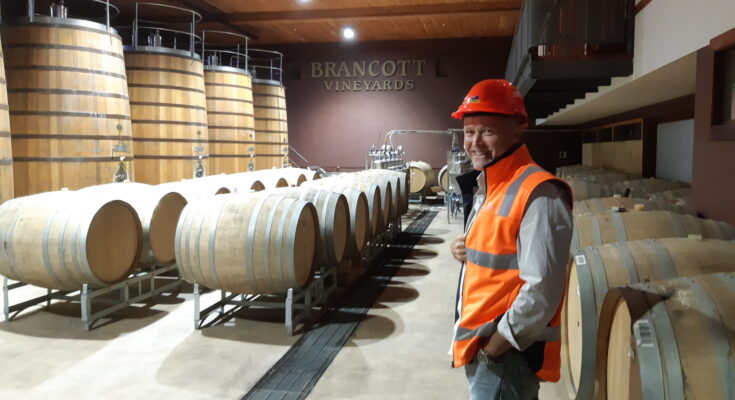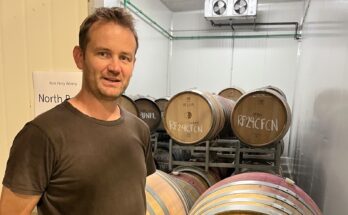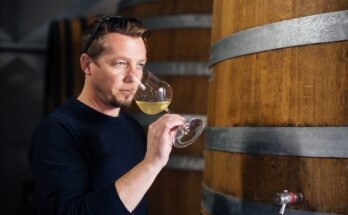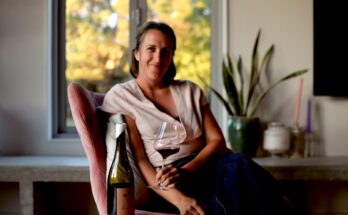WineFolio is back amongst it with another in our most popular series where we meet New Zealand’s winemaking talent. Today, we’re reporting in from Pernod Ricard, the home of Brancott Estate and Stoneleigh amongst others, to meet Chief Winemaker – Jamie Marfell. A note – this was from a visit to Marlborough pre-COVID-19.
WineFolio: We had time this morning, so went for drive over to Yealands. Wow – vines as far as the eye can see! But beautiful landscape too, and loved the drive around. Huge though! This looks like a big facility here though too?
Jamie Marfell: We do lots – because we’re across quite a few brands. We’d be going about three million plus cases a year. We’re still very strong domestically – the old Montana portfolio… we’ve still got Stoneleigh and those brands that are still doing really well for us. Montana is still one of the largest brands in New Zealand – with Sauvignon Blanc and people still drinking Montana.
It’s funny that I’ve got that old blazer here (on the rack is hanging an old school style blazer) because one of the guys here, Eddie Frost, retired last year. And that was his original jacket – back in the day we had one jacket to share! You’d go to dinner and share the jacket.
We’ve got wines and spirits in our portfolio – including the likes of Jacob’s Creek. We’re in supermarkets, but we have a bit of fine wine as well – it’s broad. In Hawke’s Bay we’ve got Church Road, then Marlborough and two hundred hectares in Waipara too. We’re one of the largest producers down there. We’ve got the Camshorn label which has taken off in Australia.
WF: Rosé is quite the business now too?
JM: Yes it is, and it’s still growing – as a percentage of the business. It’s interesting to see it grow – it’s just sneaked past Pinot Gris I think. It’s not trend, more like a solid category – sales of something like Jacob’s Creek rosés are through the roof. Sav Blanc has stopped growing so much – not flat-lining yet, and I’m not sure if rosé is taking away from it. It sits in that aperitif category – light, fresh, real vibrant, not too sweet or too dry – just beautiful, and a nice wine. We have blocks set aside to make rose. We’re taking our red wines up to 23.5 to 24, but we’re seriously looking at them at 21 to 22. Personally I’d still want the alcohol to be around 12.5 to 13 – you need that alcohol sweetness that delivers. If you go a bit mean, the wines tend to be bright but without that textual interest. Most of our rosés sit around the 4.5 to 5.5 grams of sugar; just off the palate – soft and bright and fresh.
WF: Are you doing anything in the zero alcohol area?
JM: Globally it’s a thing we’re looking at at the moment, but we’ve got nothing on the market right now. We’re at that 9% but haven’t moved into that zero alcohol space. Our cask wine sits at 5% and has done for years and years. We’ve been tasting for the last 2-3 years, and watching the movement.
But you’ve got to be comfortable that you can produce something which is representative of Marlborough, and New Zealand and put our hand on heart and say ‘this is just as good, if not better than the classic 13%’. You could do a lot of damage to your reputation if you’re not delivering that.
WF: I think Giesen are going to show me their 0% later today, it will be interesting to see what it is like.
WF: Do you still make wine? Chief winemaker – its not all just meetings and spreadsheets?
JM: No, still heavily involved – think it’s important. I go to vineyards – was out there this morning, and tomorrow we’ll be out making decisions with the guys. I think it’s important not to get yourself too far removed. I can’t carry the title and then not do it. We also need to bring the young guys through – we’ve got a couple of young winemakers in their 20s and we just need to feed as much information as possible into them. You have to see stuff. Taste stuff. It’s hard to put a measure on how valuable that is. I’m quite visual, so I like to see it, and talk about it.
WF: And do you see it as scientific or creative?
JM: It’s always going to be a combination I think, because you lay the groundwork with the science – the testing of the fruit will give you an idea of what you’re getting; but then the creative part of when you see it, feel it, touch it… there’s always that aspect to it. It’s like talking about terroir – people underestimate terroir.
Also, the way we make wine here in Marlborough – the people, the age of the industry – has quite an influence in the style of wine we make. We’re gifted with beautiful weather and great soils but the people side of it is really important. The innovations and how we make our wines is really important. You work to your environment, so in North Canterbury or Central – the way you make it is different. We do ‘Last Shepherd’ Pinot Noir, and it’s quite a big Pinot Noir – about 15,000 cases, so it’s a good size. But you actually have to be down there – see it, touch it and then talk to the people and understand how they’re doing it. You get a feel and it’s a different thought pattern about how you make Pinot Noir in Central Otago. And Waipara is completely different again.
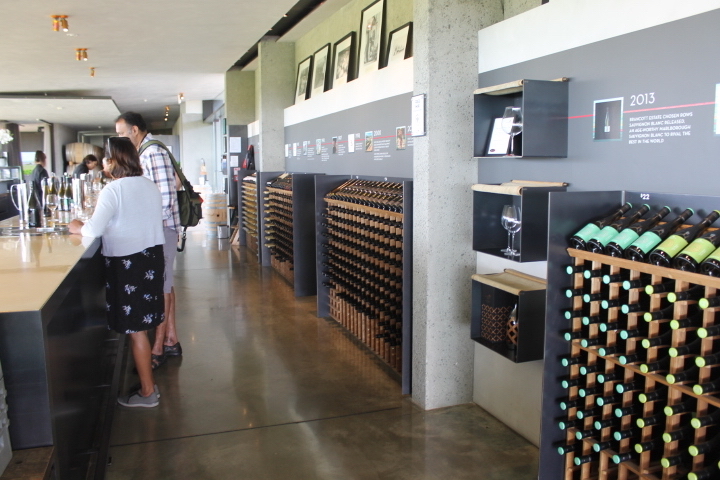
WF: That’s an almost European method of thinking about it. Rather than say “I’ll take this fruit and follow a recipe”
JM: I was just down in Waipara on Friday and a lot of our Pinot there is un-irrigated. It’s been a bloody dry year there, so the berries are tiny. But the philosophy is completely different. Waipara is quite unique, and for us it’s similar to Martinborough – we see the fruit from both, and they’ve both got very similar styles. But don’t underestimate the people factor – the creative aspect.
WF: is there a point during the year where you just get “a feeling”?
JM: You look in the vineyards for the first time and think ‘here we go’. Once you get to veraison right now, you start seeing stuff and touching it. My Eureka moment is – and it brings me back to why we do this – just after ferment’s finished when you kind of think you know what you’re doing, and all of a sudden the wine gives back to you a little bit. Maybe it delivers more than you expect, and ‘oh didn’t see that coming’? You get a kick out of what you’re getting. You always like to think you make the right decision at the right time, to make the right wine. There’s a lot of people though, and little things – like making sure the water goes on at the right time – that add up to the big picture stuff.
WF: Do you have to make tough decisions in terms of what goes in where?
JM: No, not really. We know what we have to make, so basically you go by the numbers. I’ve got a big spreadsheet that tells me ‘you need to make so much Sav Blanc’. Then you’ve got all your tops and bottoms – top-end single vineyards, and wild-fermented for example. And we tend to make “up”.
WF: Do you have plans for anything else like a real belter of a wine – for example Chris makes the “Tom” over at Church Road?
JM: We’ve got the ‘Chosen Rows’ Sav Blanc – that sells for $100. That’s the top tier of Brancott. And we are about to release a top Chardonnay and Pinot Noir for Stoneleigh at the end of this year. ‘Chosen Rows’ was first done in 2010 and we’ve thought about the Stoneleigh ones for the last four years. Interesting, Chris will be picking up an award we’ve won for our bubbles at the Easter Show – because we’ll all be working.
WF: What do you think Climate Change has in store for the New Zealand wine industry?
JM: I think we’ll be less affected than most. The sea around us will be a buffer to some of it. Probably more seasonal changes than overall change in higher temperatures, and the dynamics will be more chaotic – more cyclones.. We kind of had that the last couple of years. I’ve been making wine since 1990 and we just don’t see this stuff – it’s kind of weird. It could be the new norm, where we just have to be very aware. In New Zealand winegrowers, everyone’s talking about climate change and sustainable wine – it’s all part of it. We’re weather experts you know! I don’t think we’ll be pulling out Sav Blanc and planting Semillon. Although – it might turn up back here – we might get it ripe for a change!
We are still less than one per cent of the world’s production. The world might change around us, which then affects our business. That might be a bigger factor to New Zealand. Even if, in Australia, it gets too hot to grow Chardonnay or even Shiraz any more – that has a big effect on us. The types of wines coming in might change; prices might go up – the dynamics might change. Five years ago, Giesen putting out a no-alcohol wine – they wouldn’t have thought about it. All the wines from this winery here, in 2020, are completely vegan – three years ago I wasn’t talking about being a vegan winery. People say “Sustainable – yes, Vegan – yes; so can you be 100% Organic?” And we’re like ‘hang on!’ But that’s today – in ten years time it wouldn’t surprise me.
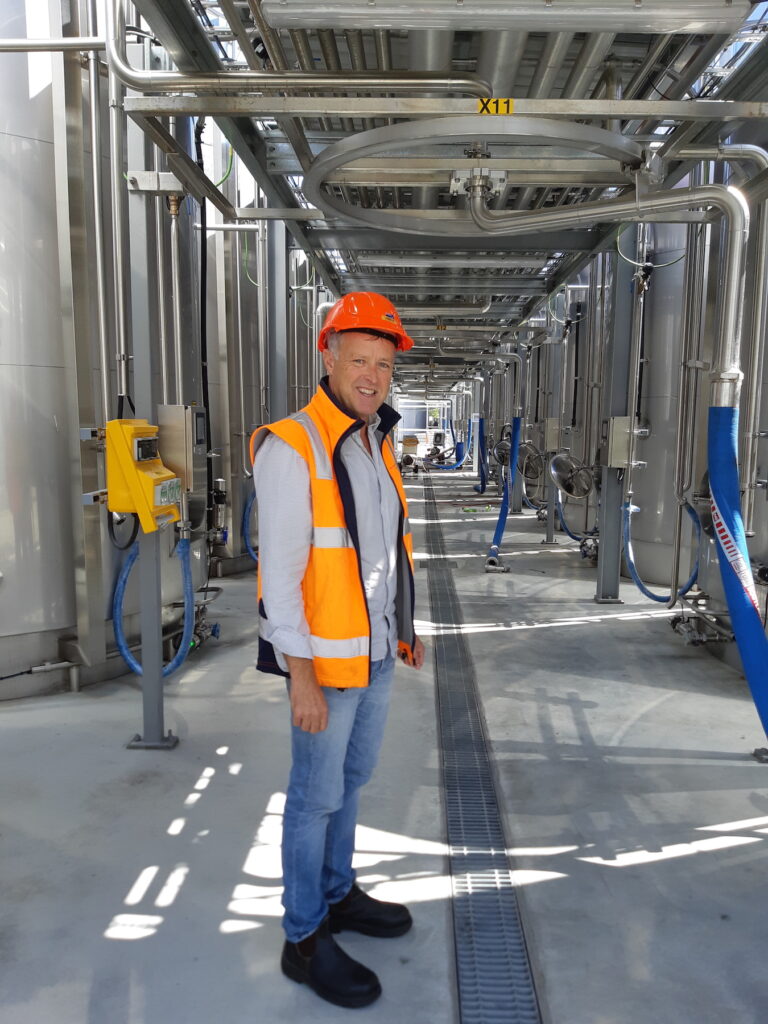
WF: But New Zealand wine is in an exciting phase, so whilst you’re in this development, you may as well feed some of those things in at in at the same time? If you were just standing still, you might say, well, no. But there’s this massive growth. Central Otago Pinot, I think, now stands up there with Marlborough Sauvignon Blanc as, now, two great types of New Zealand wine. And I think the two next things will be Sparkling, and then, Chardonnay – that also become identifiably New Zealand iconic wine styles.
JM: We’ve been planting Chardonnay and focussing on it for four or five years. If you want to be taken it seriously as a brand, then you need a top Chardonnay. It’s been a huge focus, and now we’ve had Trophy-winning wines. The same with bubbles – we’ve got Deutz Petit Cordon, and we haven’t really changed much there in philosophy.
The winery got quite heavily damaged in the earthquake. It’s the oldest winery in Marlborough and a lot of the tanks were relocated from Auckland, and a large percentage of the tanks had some kind of damage after the earthquake. So, we’ve rebuilt nearly the whole winery to a point where it’s resilient for earthquakes. And the other thing is – Health and Safety said “If we had that earthquake during the day with staff around, we probably would have lost lives”. Basically the tanks were collapsing; catwalks were collapsing on top of tanks. So in rebuilding it, we wanted to take that whole Health and safety risk out of it. We’re doing away completely with catwalks. What we’ve developed is Smart Tanks and taken away the requirement to go to the top of a tank. Put in automation in different forms, and that allows us to get to the top of the tank. Putting wine over the top, washing over the top, and additions over the top – everything you’d normally do, but using technology.
WF: Is one of the reasons that New Zealand wine has got so good, so quickly, because we use the technology?
JM: We’re moving to automated valves, to automate processes and minimal risk – so we can hook this up to crossflows for example, and it’s all above your head, not under your feet. We’ve got fixed lines everywhere with short hose lengths going up to a centre pivot, so to hook up a job and get it going takes one person. We’ve also had to do things like re-do foundations, chop the bottom off tanks, and this is the first year we’ve actually had everything working for a change. A fully fitted-out, operational winery, which has all the gear, the bells and whistles – it’s quite exciting.
With our large format oak – we’ve got a lot of puncheons and lots of cuves. We use large format oak for our Sav Blancs – like our Rapaura series. Deutz Petit Cordon, we do fermentation in these. 100% of the Chosen Rows goes into this – hand-picked, whole bunch pressed, no sulphur, wild fermented in these. Our Rapaura series Pinot Gris goes in here – we’re starting to push that more into the richer Alsatian style. All our Pinots are wild fermented now and most of our Chardonnay and Pinot Gris. We’re doing bigger and bigger volumes; demand for that is amazing and growing. We’ll have about 300 different ferments going this year.

